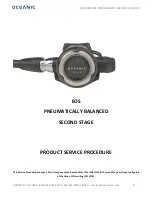
14
15
XII.
XII.
XII.
XII.
XII. Other Measurement T
Other Measurement T
Other Measurement T
Other Measurement T
Other Measurement Techniques
echniques
echniques
echniques
echniques
Known Addition (for Ag
+
or S
2-
)
An unknown concentration can be determined by adding a
known amount (volume and concentration) of measured
ion to a known volume of the sample. This technique is
called Known Addition. The method can use an ideal
sensor slope, but actual determined slopes at the tempera-
ture of measurement should be used if known. This method
is preprogrammed in the Hanna HI 4222 pH/ISE/mV meter,
which simplifies the method greatly.This technique is use-
ful for high ionic strength samples.
Example: Silver ion determination with known addition.
1. A 50 mL sample of unknown (Vsample) is placed in
a clean plastic beaker with a HI 4115 sensor. 2 mL of
HI 4000-00 ISA (V
ISA
)is added and the sample is
mixed well. The stable mV value (mV 1) is then re-
corded.
2. 5 mL (Vstd) of 10
-3
M (Cstd) standard is added to the
beaker and the mV value increases. The unknown
silver concentration in the original sample (Csample)
can then be determined by the following equation.
3. The procedure can be repeated with multiple samples.
C
sample
=
(
V
T
)10
∆
E/S
- (
V
S
’
)
C
standard
V
standard
V
sample
V
S
’
(
V
sample
+
V
standard
+
V
ISA
)=
V
T
(
V
sample
+
V
ISA
)=
V
S
’
Analyte Subtraction (S
2-
)
This method is based on a titration reaction, with the
electrode responsing to a reagent that reacts with the
sample being added.
A known concentration of sulfide in a sample can be
determined by using this method. A silver standard is
used as the reagent. Ions that complex with silver cannot
be present. These include Cl
-
, Br
-
, I
-
CN
-
, or SAOB. This
method assumes an ideal sensor slope, but actual
Procedure for Sulfide
1) Follow sections VIII and IX to prepare sensors for
measurement.
2) Follow section VI to prepare standards / solution.
Standards should bracket and fall within the range of
interest.
Fifty mL HI 4015-00 ISA is added to the beaker with
50 mL sample or standard. Add stir bar and mix
thoroughly and continuously before making mea-
surements. Protect these solutions from air and use
promptly.
3) Follow section VII to optimize test set-up.
4) During calibration it is best to start with lower concen-
tration samples first. Wait for a stable measurement
before recording values. Slightly longer equilibra-
tions are required at lower concentrations .
5) To prevent carry over and contamination of samples,
rinse sensors with deionized water and dab dry be-
tween samples.
Typical Linearity for HI 4015 & HI 4115
for Sulfide Measurement
-860
-840
-820
-800
-780
-760
-740
-720
-700
-680
0
1
2
3
4
5
6
7
-Log of Concentration
mV





























